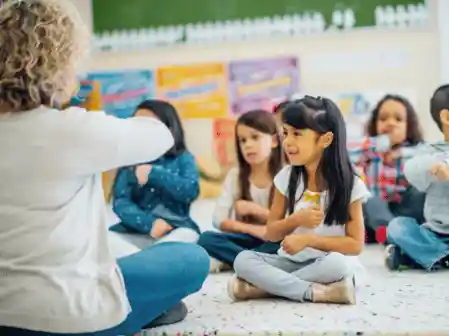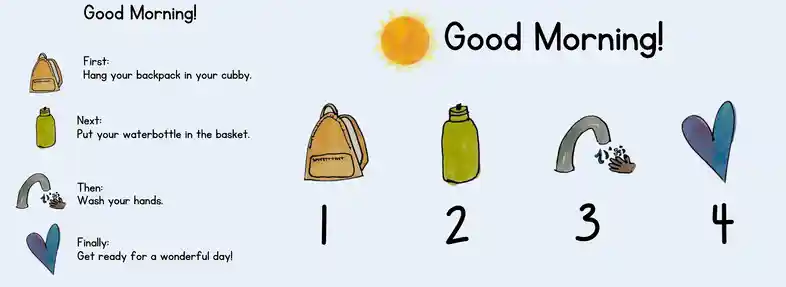Structuring Your Days for Success

Welcome Back! If you haven’t had a chance to read Part One of our Back to School Blog Series, click here!
Early Childhood Classroom Routines and Rituals
Just as your furniture arrangement is the foundation for your physical environment, a daily schedule establishes rhythm and flow for children each day. From the moment of arrival, teachers guide their students from one experience to the next, all while making many micro-decisions along the way. We know that children thrive with engaging, predictable routines. Our hunch is that most teachers do too! Let’s talk through the steps of designing a thoughtful schedule that also leaves space for spontaneity and responsiveness.
Note: Each early learning context has its own unique considerations. Licensing, accreditation, curriculum, and individual program philosophy and policies all come with their own set of requirements. Before the new year starts, it’s important to make sure you’re up to date on the latest regulations and guidelines that apply to your setting.
Define Non-Negotiables
Coordinating daily schedules can be a challenge for programs large and small. Teachers and program leaders consider many factors such as staffing, use of shared spaces, mealtimes, and more. Once teachers have identified the parts of their day that are not flexible based on the criteria specific to their setting, other elements of the daily schedule can be determined.
Minimize Transitions & Use Visual Supports
It can be difficult to shift gears! Plan for success and be mindful of the number of transitions in your day.
- Early in the year, set aside time for children to practice transitions. Offer clear, simple instructions, then model the steps involved.
- Auditory cues help children navigate transitions more easily. A bell or a chime can signal transitions to another part of the day. A special clean-up song can make the shift from play to tidying less difficult.
- Give children a heads up about upcoming transitions. Let them know how much time there is left, and what that means in the context of their activity. “Five minutes” is an abstract quantity of time for most young children. You might use that language, but also offer, “This is a good amount of time to add any finishing touches to your work, but not quite enough time to start a new project.”
- Visual timers and other visual count-down tools can help children make sense of time remaining. These tools help children SEE “how long” five minutes is.
At the beginning of the day, walk through your schedule with your students.
- Use a visual card or photo to represent each part of the day.
- Daily Schedule Pocket Chart from Becker’s includes everything you need! Or get creative and make your own.
- Make it personalized! Add photos of your students as they participate in daily activities.
- Consider the orientation of the visual schedule. Elements presented horizontally are easier to track. As visual-motor skills grow, children become more adept at tracking vertically organized information. See the illustration below for examples of similar information presented both ways.

Mastering Routines is Empowering
There’s nothing like watching a child enter their classroom and know exactly what to do as they start their day! As you plan your schedule, notice the times of day that have a routine embedded at the beginning or the end. While it takes some intentionality at the beginning of the year, leaning in to explicitly teaching routines and creating visual cues to support routines makes for smoother days and steadier, confident children! Common routines include handwashing, preparing for and tidying up from meals, and end of the day pack-up. Consider your students’ age and developmental stage as you scaffold their experiences; many preschoolers need support following multi-step directions.

Use Rituals as Anchors for Connection
Classroom rituals anchor our days with meaning and connection. You might already be using classroom rituals without realizing it. Some familiar preschool rituals include special morning greetings, taking a moment for gratitude, thinking about a loved one before rest time, or sending warm wishes to an absent classmate. The important characteristic of rituals is connection. Meaningful rituals should highlight and strengthen relationships between teachers and students, among classmates, and even within your wider school community. Schedule rituals for a calm time of day when you won’t feel hurried or distracted.
While some rituals are planned for, others may evolve naturally. One year, I taught a group of children that decided to start every Monday morning by announcing all of the sweet treats they enjoyed over the weekend. They named this self-made ritual “Sugar Shares!” Think about rituals that are meaningful to you and your students that you would like to incorporate into your days and stay open to opportunities for creating new rituals as your year progresses.
Our friends at Yellow Door share wonderful ideas to inspire kindness and gratitude rituals in the classroom. Check out their blog here.
Your Turn!
Thoughtful routines and rituals provide a predictable environment and foster a sense of security. Children thrive with consistent schedules and expectations! Visual schedules, auditory and visual cues, and well supported transitions help children navigate their day with confidence and comfort. Which of these techniques are you already implementing? Are any suggestions interesting or inspiring? How will you plan for success this school year?
Ready to Learn More?
Did you miss our two Back to School planning webinars? No problem! You can watch the recordings and download all the resources - click on one of the images below!

Christine Murray is an Early Childhood Education Specialist with Becker’s Education Team.
As an educator, coach and leader, Christine is inspired by the curiosity, joy and wonder that children so generously model for us. She earned her M.A. in Innovative Early Childhood Education at the University of Colorado Denver and loves collaborating with and supporting others in the field. Grounded in relationships and guided by empathy, Christine is always learning, connecting and creating.


